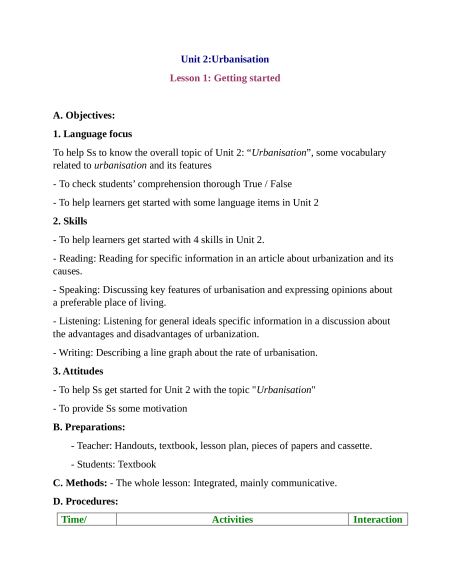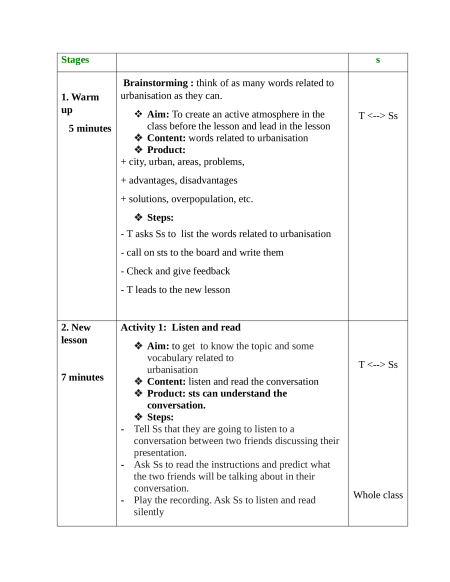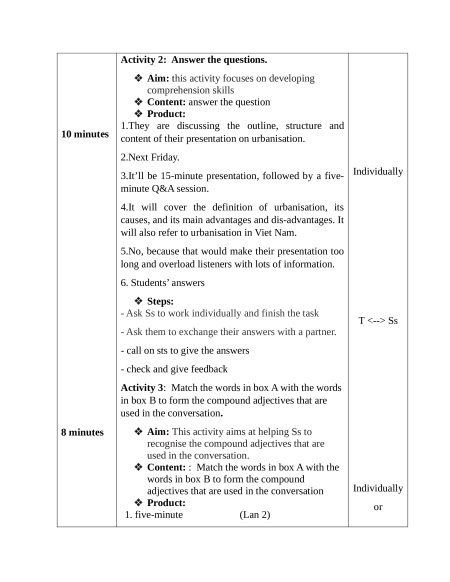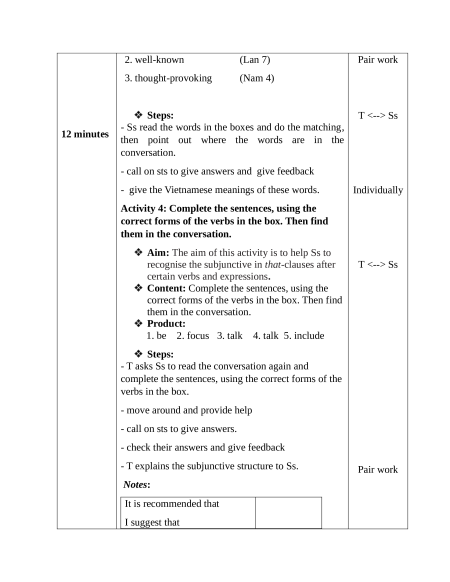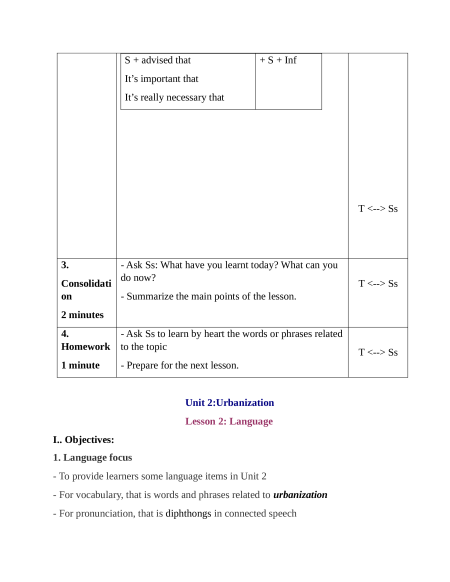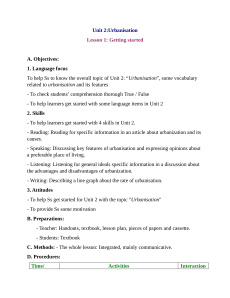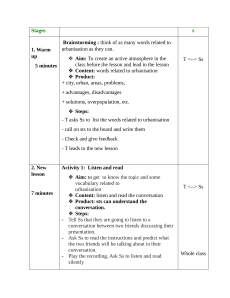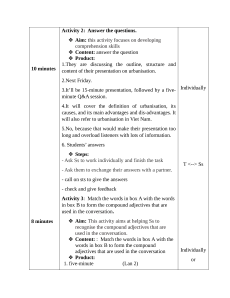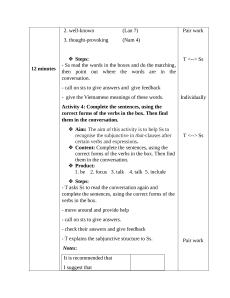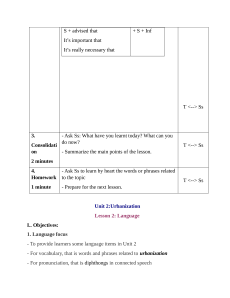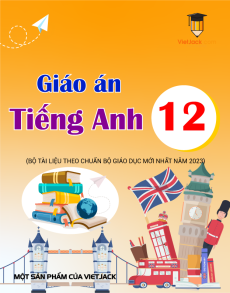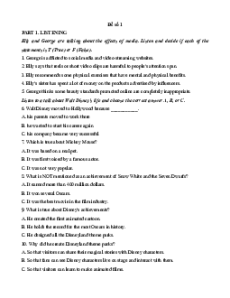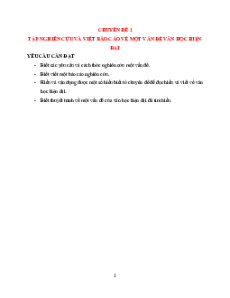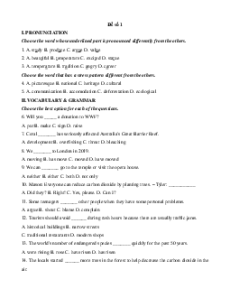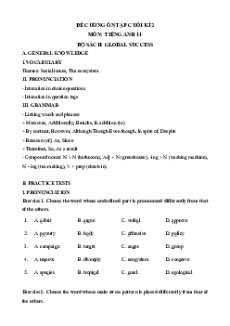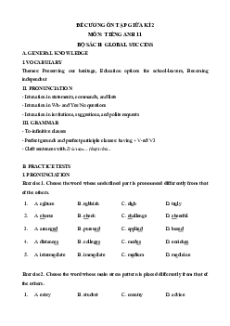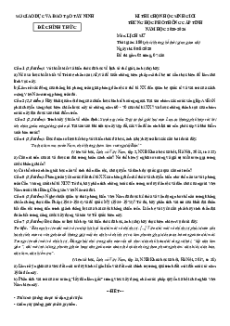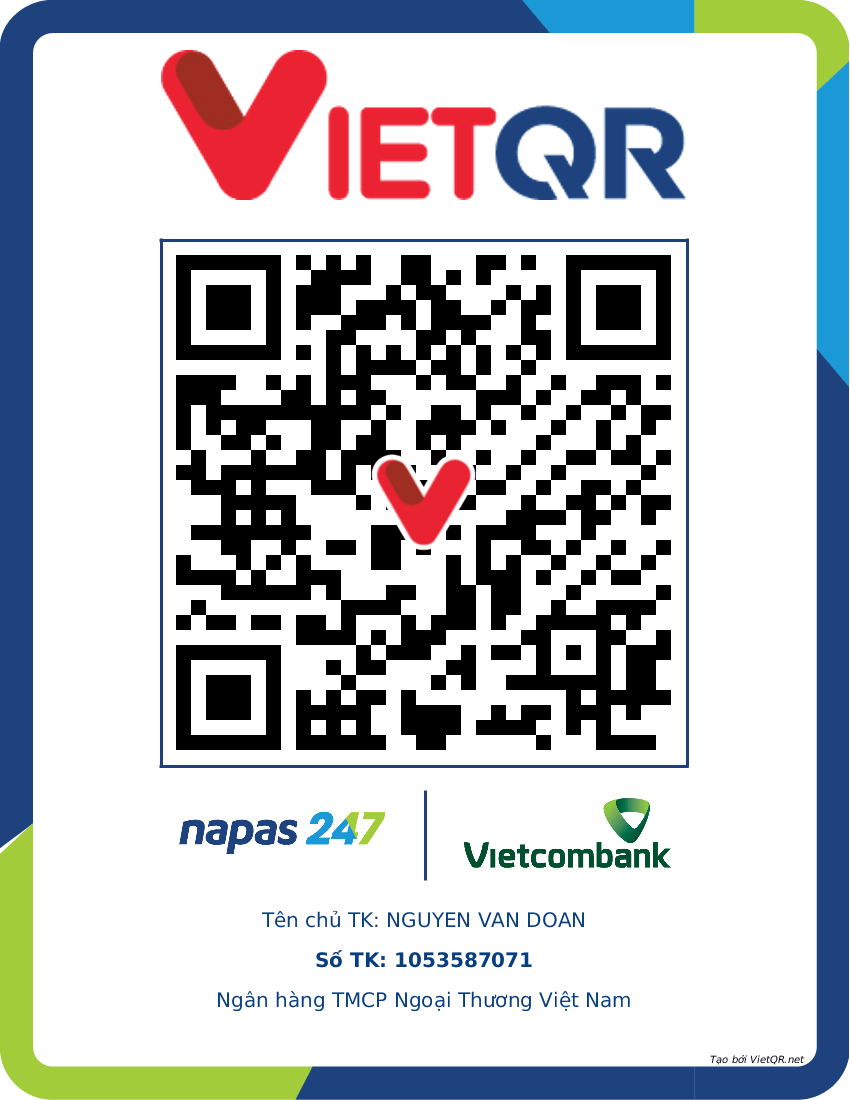Unit 2:Urbanisation
Lesson 1: Getting started A. Objectives: 1. Language focus
To help Ss to know the overall topic of Unit 2: “Urbanisation”, some vocabulary
related to urbanisation and its features
- To check students’ comprehension thorough True / False
- To help learners get started with some language items in Unit 2 2. Skills
- To help learners get started with 4 skills in Unit 2.
- Reading: Reading for specific information in an article about urbanization and its causes.
- Speaking: Discussing key features of urbanisation and expressing opinions about a preferable place of living.
- Listening: Listening for general ideals specific information in a discussion about
the advantages and disadvantages of urbanization.
- Writing: Describing a line graph about the rate of urbanisation. 3. Attitudes
- To help Ss get started for Unit 2 with the topic "Urbanisation"
- To provide Ss some motivation B. Preparations:
- Teacher: Handouts, textbook, lesson plan, pieces of papers and cassette. - Students: Textbook
C. Methods: - The whole lesson: Integrated, mainly communicative. D. Procedures: Time/ Activities Interaction Stages s
Brainstorming : think of as many words related to 1. Warm urbanisation as they can. up
Aim: To create an active atmosphere in the T <--> Ss 5 minutes
class before the lesson and lead in the lesson
Content: words related to urbanisation Product:
+ city, urban, areas, problems, + advantages, disadvantages
+ solutions, overpopulation, etc. Steps:
- T asks Ss to list the words related to urbanisation
- call on sts to the board and write them - Check and give feedback - T leads to the new lesson 2. New
Activity 1: Listen and read lesson
Aim: to get to know the topic and some vocabulary related to urbanisation T <--> Ss 7 minutes
Content: listen and read the conversation
Product: sts can understand the conversation. Steps:
- Tell Ss that they are going to listen to a
conversation between two friends discussing their presentation.
- Ask Ss to read the instructions and predict what
the two friends will be talking about in their conversation.
- Play the recording. Ask Ss to listen and read Whole class silently
Activity 2: Answer the questions.
Aim: this activity focuses on developing comprehension skills
Content: answer the question Product:
1.They are discussing the outline, structure and 10 minutes
content of their presentation on urbanisation. 2.Next Friday.
3.It’ll be 15-minute presentation, followed by a five- Individually minute Q&A session.
4.It will cover the definition of urbanisation, its
causes, and its main advantages and dis-advantages. It
will also refer to urbanisation in Viet Nam.
5.No, because that would make their presentation too
long and overload listeners with lots of information. 6. Students’ answers Steps:
- Ask Ss to work individually and finish the task T <--> Ss
- Ask them to exchange their answers with a partner.
- call on sts to give the answers - check and give feedback
Activity 3: Match the words in box A with the words
in box B to form the compound adjectives that are
used in the conversation. 8 minutes
Aim: This activity aims at helping Ss to
recognise the compound adjectives that are used in the conversation.
Content: : Match the words in box A with the
words in box B to form the compound
adjectives that are used in the conversation Individually Product: or 1. five-minute (Lan 2) 2. well-known (Lan 7) Pair work 3. thought-provoking (Nam 4) Steps: T <--> Ss
- Ss read the words in the boxes and do the matching, 12 minutes
then point out where the words are in the conversation.
- call on sts to give answers and give feedback
- give the Vietnamese meanings of these words. Individually
Activity 4: Complete the sentences, using the
correct forms of the verbs in the box. Then find them in the conversation.
Aim: The aim of this activity is to help Ss to
recognise the subjunctive in that-clauses after T <--> Ss
certain verbs and expressions.
Content: Complete the sentences, using the
correct forms of the verbs in the box. Then find them in the conversation. Product:
1. be 2. focus 3. talk 4. talk 5. include Steps:
- T asks Ss to read the conversation again and
complete the sentences, using the correct forms of the verbs in the box. - move around and provide help - call on sts to give answers.
- check their answers and give feedback
- T explains the subjunctive structure to Ss. Pair work Notes: It is recommended that I suggest that
Giáo án Unit 2: Urbanisation Tiếng Anh 12 (mới CV 5512)
420
210 lượt tải
MUA NGAY ĐỂ XEM TOÀN BỘ TÀI LIỆU
CÁCH MUA:
- B1: Gửi phí vào TK:
1133836868- CT TNHH DAU TU VA DV GD VIETJACK - Ngân hàng MB (QR) - B2: Nhắn tin tới Zalo VietJack Official ( nhấn vào đây ) để xác nhận thanh toán và tải tài liệu - giáo án
Liên hệ ngay Hotline hỗ trợ: 084 283 45 85
Bộ giáo án Tiếng Anh 9 (mới CV5512) được cập nhật liên tục trong gói này từ nay đến hết tháng 3/2024.
Để tải tài liệu gốc về máy bạn click vào nút Tải Xuống ở trên!
Thuộc bộ (mua theo bộ để tiết kiệm hơn):
- Bộ giáo án Tiếng Anh 12 mới CV 5512 chuẩn nhất được thiết kế theo phong cách hiện đại, đẹp mắt, trình bày chi tiết cho từng bài học và bám sát chương trình Sách giáo khoa Tiếng Anh 12.
- Mua trọn bộ sẽ tiết kiệm hơn tải lẻ 50%.
Đánh giá
4.6 / 5(420 )5
4
3
2
1
Trọng Bình
Tài liệu hay
Giúp ích cho tôi rất nhiều
Duy Trần
Tài liệu chuẩn
Rất thích tài liệu bên VJ soạn (bám sát chương trình dạy)
TÀI LIỆU BỘ BÁN CHẠY MÔN Tiếng Anh
Xem thêmTÀI LIỆU BỘ BÁN CHẠY Lớp 12
Xem thêmTài liệu bộ mới nhất

Unit 2:Urbanisation
Lesson 1: Getting started
A. Objectives:
1. Language focus
To help Ss to know the overall topic of Unit 2: “Urbanisation”, some vocabulary
related to urbanisation and its features
- To check students’ comprehension thorough True / False
- To help learners get started with some language items in Unit 2
2. Skills
- To help learners get started with 4 skills in Unit 2.
- Reading: Reading for specific information in an article about urbanization and its
causes.
- Speaking: Discussing key features of urbanisation and expressing opinions about
a preferable place of living.
- Listening: Listening for general ideals specific information in a discussion about
the advantages and disadvantages of urbanization.
- Writing: Describing a line graph about the rate of urbanisation.
3. Attitudes
- To help Ss get started for Unit 2 with the topic "Urbanisation"
- To provide Ss some motivation
B. Preparations:
- Teacher: Handouts, textbook, lesson plan, pieces of papers and cassette.
- Students: Textbook
C. Methods: - The whole lesson: Integrated, mainly communicative.
D. Procedures:
Time/ Activities Interaction

Stages s
1. Warm
up
5 minutes
Brainstorming : think of as many words related to
urbanisation as they can.
Aim: To create an active atmosphere in the
class before the lesson and lead in the lesson
Content: words related to urbanisation
Product:
+ city, urban, areas, problems,
+ advantages, disadvantages
+ solutions, overpopulation, etc.
Steps:
- T asks Ss to list the words related to urbanisation
- call on sts to the board and write them
- Check and give feedback
- T leads to the new lesson
T <--> Ss
2. New
lesson
7 minutes
Activity 1: Listen and read
Aim: to get to know the topic and some
vocabulary related to
urbanisation
Content: listen and read the conversation
Product: sts can understand the
conversation.
Steps:
- Tell Ss that they are going to listen to a
conversation between two friends discussing their
presentation.
- Ask Ss to read the instructions and predict what
the two friends will be talking about in their
conversation.
- Play the recording. Ask Ss to listen and read
silently
T <--> Ss
Whole class

10 minutes
8 minutes
Activity 2: Answer the questions.
Aim: this activity focuses on developing
comprehension skills
Content: answer the question
Product:
1.They are discussing the outline, structure and
content of their presentation on urbanisation.
2.Next Friday.
3.It’ll be 15-minute presentation, followed by a five-
minute Q&A session.
4.It will cover the definition of urbanisation, its
causes, and its main advantages and dis-advantages. It
will also refer to urbanisation in Viet Nam.
5.No, because that would make their presentation too
long and overload listeners with lots of information.
6. Students’ answers
Steps:
- Ask Ss to work individually and finish the task
- Ask them to exchange their answers with a partner.
- call on sts to give the answers
- check and give feedback
Activity 3: Match the words in box A with the words
in box B to form the compound adjectives that are
used in the conversation.
Aim: This activity aims at helping Ss to
recognise the compound adjectives that are
used in the conversation.
Content: : Match the words in box A with the
words in box B to form the compound
adjectives that are used in the conversation
Product:
1. five-minute (Lan 2)
Individually
T <--> Ss
Individually
or

12 minutes
2. well-known (Lan 7)
3. thought-provoking (Nam 4)
Steps:
- Ss read the words in the boxes and do the matching,
then point out where the words are in the
conversation.
- call on sts to give answers and give feedback
- give the Vietnamese meanings of these words.
Activity 4: Complete the sentences, using the
correct forms of the verbs in the box. Then find
them in the conversation.
Aim: The aim of this activity is to help Ss to
recognise the subjunctive in that-clauses after
certain verbs and expressions.
Content: Complete the sentences, using the
correct forms of the verbs in the box. Then find
them in the conversation.
Product:
1. be 2. focus 3. talk 4. talk 5. include
Steps:
- T asks Ss to read the conversation again and
complete the sentences, using the correct forms of the
verbs in the box.
- move around and provide help
- call on sts to give answers.
- check their answers and give feedback
- T explains the subjunctive structure to Ss.
Notes:
It is recommended that
I suggest that
Pair work
T <--> Ss
Individually
T <--> Ss
Pair work

S + advised that
It’s important that
It’s really necessary that
+ S + Inf
T <--> Ss
3.
Consolidati
on
2 minutes
- Ask Ss: What have you learnt today? What can you
do now?
- Summarize the main points of the lesson.
T <--> Ss
4.
Homework
1 minute
- Ask Ss to learn by heart the words or phrases related
to the topic
- Prepare for the next lesson.
T <--> Ss
Unit 2:Urbanization
Lesson 2: Language
I.. Objectives:
1. Language focus
- To provide learners some language items in Unit 2
- For vocabulary, that is words and phrases related to urbanization
- For pronunciation, that is diphthongs in connected speech
